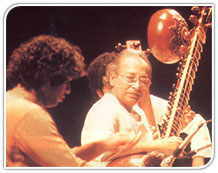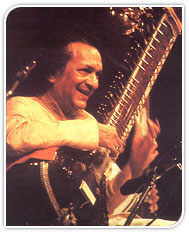Music of India: Sitar
 The
invention of Sitar is commonly credited to Amir Khusrau, a courtier of
lauddin Khiiji in the 13th Century.
The
invention of Sitar is commonly credited to Amir Khusrau, a courtier of
lauddin Khiiji in the 13th Century.
The name Sitar was derived
from Persian 'Seh-tar' meaning 'three strings' which the instrument
originally had.
But the modern Sitar has seven strings fastened
to the pegs on the neck and the sides.
Sixteen to twenty-two
frets are secured to the finger-board by pieces of gut. There are also 11
to 12 sympathetic strings below the frets, running parallel to the main
strings.
 The
instrument is played by means of a wire plectrum worn on the forefinger of
the right hand. It was instrumental in introducing western audiences to
Indian Classical music.
The
instrument is played by means of a wire plectrum worn on the forefinger of
the right hand. It was instrumental in introducing western audiences to
Indian Classical music. The
invention of Sitar is commonly credited to Amir Khusrau, a courtier of
lauddin Khiiji in the 13th Century.
The
invention of Sitar is commonly credited to Amir Khusrau, a courtier of
lauddin Khiiji in the 13th Century.  The
instrument is played by means of a wire plectrum worn on the forefinger of
the right hand. It was instrumental in introducing western audiences to
Indian Classical music.
The
instrument is played by means of a wire plectrum worn on the forefinger of
the right hand. It was instrumental in introducing western audiences to
Indian Classical music.